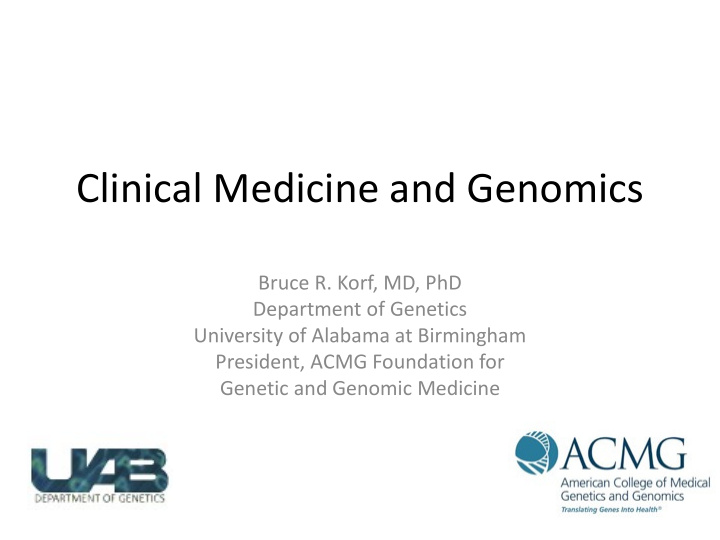



Clinical Medicine and Genomics Bruce R. Korf, MD, PhD Department of Genetics University of Alabama at Birmingham President, ACMG Foundation for Genetic and Genomic Medicine
Evidence from the United States and abroad suggests inadequate genetics education of health care professionals as a significant factor limiting the integration of genetics into clinical care. Specific inadequacies include the amount and type of genetics content included in undergraduate professional school curricula and the small amount of genetics- related knowledge and skills of physicians, nurses, and other health professionals once they enter clinical practice. Modifications in medical, dental, nursing, public health, and pharmacy school curricula and in medical residency training programs are needed to ensure that health care professionals entering the workforce are well-trained in genetics.
Multiple Endocrine Neoplasia 1 Parathyroid tumors Pituitary tumors Gastro-entero-pancreatic tumors Carcinoid Adrenocorticoid tumors Angiofibromas, meningiomas, ependymomas, etc. Known pathogenic 18 months old mutation Mutation not present in child VUS not present in mother pathogenic benign Variant of uncertain significance
Competencies Determine risk to child based on dominant inheritance of MEN1 Recognize that child will benefit from diagnosis (? at 18 months) Order MEN1 genetic testing Appreciate significance of VUS Test affected relative first Formulate appropriate care plan
What are the necessary knowledge and skill sets required for analyzing, interpreting, and utilizing genomic information? • Focus on competencies, not knowledge … • … point-of-care decision support tools may guide clinical use … • … but a health provider should be able to explain why, not only what and how
Diagnostic Testing
= Breast = Lung = Prostate = Ovarian = Leukemia BRCA1+ BRCA1-
CCCCGTGGGAACACTGGGAGCCTGCACTCCACAGACCCTCTCCTTGCCTCTTCCCTCACCTCAGCC CCGCTCCCCGCCCTCTTCCCGGCCCAGGGCGCCGGCCCACCCTTCCCTCCGCCGCCCCCCGGCCG GGGGAGGACATGGCCGCGCACAGGCCGGTGGAATGGGTCCAGGCCGTGGTCAGCCGCTTCGACG AGCAGCTTCCAATAAAAACAGGACAGCAGAACACACATACCAAAGTCAGTACTGAGCACAACAAGGA ATGTCTAATCAATATTTCCAAATACAAGTTTTCTTTGGTTATAAGCGGCCTCACTACTATTTTAAAGAATG TAACTATATGAGAATATTTGGAGAAGCTGCTGAAAAAAATTTATATCTCTCTCAGTTGATTATATTGGA ACACTGGAAAAATGTCTTGCTGGGCAACCAAAGGACACAATGAGATTAGATGAAACGATGCTGGTCA AACAGTTGCTGCCAGAAATCTGCCATTTTCTTCACACCTGTCGTGAAGGAAACCAGCATGCAGCTGA TTCGGAATTCTGCCTCTGGGGTTTTATTTTCTCTCAGCTGCAACAACTTCAATGCAGTCTTTAGTCGC TTCTACCAGGTTACAGGAATTAACTGTTTGTTCAGAAGACAATGTTGATGTTCATGATATAGAATTGTT ACAGTATATCAATGTGGATTGTGCAAAATTAAAACGACTCCTGAAGGAAACAGCATTTAAATTTAAAGC CTAAAGAAGGTTGCGCAGTTAGCAGTTATAAATAGCCTGGAAAAGGCATTTTGGAACTGGGTAGAA ATTATCCAGATGAATTTACAAAACTGTACCAGATCCCACAGACTGATATGGCTGAATGTGCAGAAAAG ATTTGACTTGGTGGATGGTTTTGCTGAAAGCACCAAACGTAAAGCAGCAGTTTGGCCACTACAAATC ATTCTCCTTATCTTGTGTCCAGAAATAATCCAGGATATATCCAAAGACGTGGTTGATGAAAACAACATG ATAAGAAGTTATTTCTGGACAGTCTACGAAAAGCTCTTGCTGGCCATGGAGGAAGTAGGCAGCTGAC GAAAGTGCTGCAATTGCCTGTGTCAAACTGTGTAAAGCAAGTACTTACATCAATTGGGAAGATAACTC GTCATTTTCCTACTTGTTCAGTCCATGGTGGTTGATCTTAAGAACCTGCTTTTTAATCCAAGTAAGCCAT CTCAAGAGGCAGTCAGCCTGCAGATGTGGATCTAATGATTGACTGCCTTGTTTCTTGCTTTCGTATAA GCCCTCACAACAACCAACACTTTAAGATCTGCCTGGCTCAGAATTCACCTTCTACATTTCACTATGTGC GGTAAATTCACTCCATCGAATCATCACCAATTCCGCATTGGATTGGTGGCCTAAGATTGATGCTGTGT ATTGTCACTCGGTTGAACTTCGAAATATGTTTGGTGAAACACTTCATAAAGCAGTGCAAGGTTGTGGA GCACACCCAGCAATACGAATGGCACCGAGTCTTACATTTAAAGAAAAAGTAACAAGCCTTAAATTTAA GAAAAACCTACAGACCTGGAGACAAGAAGCTATAAGTATCTTCTCTTGTCCATGGTGAAACTAATTCA GCAGCTCCAAAGCTCTTGCTTTGTAATCCAAGAAAACAGGGGCCCGAAACCCAAGGCAGTACAGCA AATTAATTACAGGGCTCGTCCAACTGGTCCCTCAGTCACACATGCCAGAGATTGCTCAGGAAGCAAT GAGGCTCTGCTGGTTCTTCATCAGTTAGATAGCATTGATTTGTGGAATCCTGATGCTCCTGTAGAAAC TTTGGGAGATTAGCTCACAAATGCTTTTTTACATCTGCAAGAAATTAACTAGTCATCAAATGCTTAGTA GCACAGAAATTCTCAAGTGGTTGCGGGAAATATTGATCTGCAGGAATAAATTTCTTCTTAAAAATAAGC
Competencies • Recognize indications for testing • Select appropriate family member to test first • Discuss issues of payment/risks/benefits • Select a laboratory • Interpret report – recognize limitations • Genomic sequencing – recognize potential for secondary findings • Refer to specialist as needed • Discuss results with family
Newborn Screening
Therapeutics N Engl J Med 2001; 344:1084-1086, Apr 5, 2001.
Pharmacogenetics
Risk Assessment
What are the training needs for an individual and what is not being addressed? • Need to establish a vector of competency – Attract students to careers – Health professional students should enter better prepared – Integrate genetics into health professional education and residency – MOC may present an opportunity Pre-health Medical Residency CME/MOC professional education
Medical Education
Personalized Healthcare Competencies Project Genomics Pre-Health Professional Health Professional Undergraduate Pharmacogenetics Engineering General Business Law Informatics Culture & Environment
ACMGF Summer Scholars Program
Banbury Summit I & II (2004, 2006) • Increase numbers of trainees • What is a medical geneticist?
ACMG Competencies
ACMG Genomics Academy Principles Clinical Laboratory Analysis & Interpretation Interpretation & Counseling
New Educational Paradigms
What is needed to translate genomic information from the lab to the provider? Will collaborative medicine be needed to interpret genomic information? • We are a long way from having fully annotated the genome • Point-of-care decision support tools need to be deployed • Collaborative partnerships will be key • New counseling paradigms will be needed
Recommend
More recommend